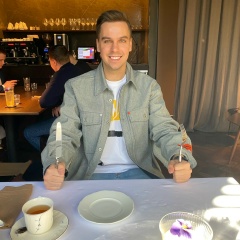полгода ждал выхода этого фильма: во-первых, у него совершенно потрясающий трейлер (см. ниже); во-вторых, мне эта тема совсем не чужая, я на истфаке писал курсовую по ранним Рюриковичам - остались, знаете, очень яркие впечатления от изучения источников...
по итогам просмотра, если совсем коротко: историческое содержание и художественный стиль выдержаны на 3+. дело даже не в том, что в 2-3-минутном ролике собрали самые эффектные сцены (это нормально, да и есть на что в фильме посмотреть и помимо них) - в полном метре неизбежно (наверное?) теряются необходимые для сюжета темп и ритм, когда, как и бывало в средневековых реалиях, пара неброских фраз могла определить ход политических событий целой страны или региона на столетия вперёд...
короче, из плюсов:
* отлично переданная атмосфера раннего Средневековья - с его грязью, кровью и примитивной жестокостью, которые проходят общим фоном к событийной канве;
* очень достоверная работа костюмеров (хотя, в отличие от какой-нибудь "Игры престолов", разнообразием гардероба героев явно не балуют - разве что у Ходченковой (Ирина) аж три смены одеяний, остальным вполне хватает и одного костюма на весь фильм);
* неплохие комбинированные съемки с рапидом и "перетеканием" кадров - муражки по коже таки периодически пробегают...
из минусов:
*много. очень много прямых расхождений с текстом "Повести временных лет" и прочих источников - иногда это объяснимо и простительно (например, Олегу на начало заварухи с охотой в 975-м было, по летописи, лишь 13 лет, а Владимиру, когда он насиловал Рогнеду и греческую жену Ярополка (имя "Ирина" в фильме взято абсолютно с потолка) в 980-м - в лучшем случае 14 лет и т.п. - с датировкой в ПВЛ вообще много нестыковок),
но иногда это всерьёз выбивает из колеи: почему Свенельд вдруг оказывается воеводой Олега, а не Ярополка; почему Олегу приспичило охотится именно в полоцких, а не древлянских лесах (про его сватовство к Рогнеде вообще ничего в источниках нет); почему Олег погибает в крепостном рву Полоцка, а не Овруча... и многое-многое другое - прямо вопреки тексту летописей ????
* очень убогий и неубедительный Киев, который сильно напоминает непритязательные городища славянских племён VII-VIII вв., но никак не столицу уже фактически сформировавшейся державы конца X в, которая (и это подробно описывается в летописях!) по надёжности своей фортификации допускала, например, со стороны тех же печенегов лишь многомесячные осады, но никак не приступы с использованием самых элементарных орудий, и уж тем более не угрозу взятия простым навалом...
* крайне размытая картина этнического состава участников действа: лубочные вечно обдолбанные викинги, лубочные чистенькие и грамотные ромеи, лубочные хаотично появляющиеся и исчезающие печенеги, а от восточных славян, которые, собственно, и были главными участниками всех описываемых событий, мы вообще видим лишь безликую массовку на капище и столь же безликую массовку в ходе крещения...
* абсолютная и нелепая отсебятина в сценах с атаками печенегов горящими тележными колесами и скользящими по грязи ладьями: зачем и кому был нужен этот бред?
пс: впрочем, я лишь на выходе из кинозала узнал, что из двух прокатных вариантов (12+ и 18+) смотрел лишь детский вариант - ну, может, после просмотра "взрослой" версии какие-то неувязки станут более понятными ????
по итогам просмотра, если совсем коротко: историческое содержание и художественный стиль выдержаны на 3+. дело даже не в том, что в 2-3-минутном ролике собрали самые эффектные сцены (это нормально, да и есть на что в фильме посмотреть и помимо них) - в полном метре неизбежно (наверное?) теряются необходимые для сюжета темп и ритм, когда, как и бывало в средневековых реалиях, пара неброских фраз могла определить ход политических событий целой страны или региона на столетия вперёд...
короче, из плюсов:
* отлично переданная атмосфера раннего Средневековья - с его грязью, кровью и примитивной жестокостью, которые проходят общим фоном к событийной канве;
* очень достоверная работа костюмеров (хотя, в отличие от какой-нибудь "Игры престолов", разнообразием гардероба героев явно не балуют - разве что у Ходченковой (Ирина) аж три смены одеяний, остальным вполне хватает и одного костюма на весь фильм);
* неплохие комбинированные съемки с рапидом и "перетеканием" кадров - муражки по коже таки периодически пробегают...
из минусов:
*много. очень много прямых расхождений с текстом "Повести временных лет" и прочих источников - иногда это объяснимо и простительно (например, Олегу на начало заварухи с охотой в 975-м было, по летописи, лишь 13 лет, а Владимиру, когда он насиловал Рогнеду и греческую жену Ярополка (имя "Ирина" в фильме взято абсолютно с потолка) в 980-м - в лучшем случае 14 лет и т.п. - с датировкой в ПВЛ вообще много нестыковок),
но иногда это всерьёз выбивает из колеи: почему Свенельд вдруг оказывается воеводой Олега, а не Ярополка; почему Олегу приспичило охотится именно в полоцких, а не древлянских лесах (про его сватовство к Рогнеде вообще ничего в источниках нет); почему Олег погибает в крепостном рву Полоцка, а не Овруча... и многое-многое другое - прямо вопреки тексту летописей ????
* очень убогий и неубедительный Киев, который сильно напоминает непритязательные городища славянских племён VII-VIII вв., но никак не столицу уже фактически сформировавшейся державы конца X в, которая (и это подробно описывается в летописях!) по надёжности своей фортификации допускала, например, со стороны тех же печенегов лишь многомесячные осады, но никак не приступы с использованием самых элементарных орудий, и уж тем более не угрозу взятия простым навалом...
* крайне размытая картина этнического состава участников действа: лубочные вечно обдолбанные викинги, лубочные чистенькие и грамотные ромеи, лубочные хаотично появляющиеся и исчезающие печенеги, а от восточных славян, которые, собственно, и были главными участниками всех описываемых событий, мы вообще видим лишь безликую массовку на капище и столь же безликую массовку в ходе крещения...
* абсолютная и нелепая отсебятина в сценах с атаками печенегов горящими тележными колесами и скользящими по грязи ладьями: зачем и кому был нужен этот бред?
пс: впрочем, я лишь на выходе из кинозала узнал, что из двух прокатных вариантов (12+ и 18+) смотрел лишь детский вариант - ну, может, после просмотра "взрослой" версии какие-то неувязки станут более понятными ????
six months waiting for the release of this film: firstly, he has an absolutely amazing trailer (see below); secondly, this topic isn’t a stranger to me at all, I wrote a course paper on the early Rurikovich at the history department - you know, there were very vivid impressions from studying the sources ...
according to the results of the viewing, if very briefly: the historical content and artistic style are sustained by 3+. it’s not even that the most spectacular scenes were collected in a 2-3-minute video (this is normal, and there is something to look at in the film besides them) - in full meter, the tempo and rhythm necessary for the plot are inevitably lost (probably?) when, as happened in medieval realities, a pair of discreet phrases could determine the course of political events of a whole country or region for centuries to come ...
in short, from the pros:
* Well-conveyed atmosphere of the early Middle Ages - with its filth, blood and primitive cruelty, which pass the general background to the event canvas;
* very reliable work of costumers (although, unlike some "Game of Thrones", heroes are clearly not indulged in the variety of wardrobe - except that Khodchenkova (Irina) has three changes of clothes, the rest is enough for one costume for the whole movie);
* good combined shooting with rapid speed and "flowing" frames - muzhki on the skin periodically run through ...
of the minuses:
*lot. there are a lot of direct discrepancies with the text of "The Tale of Bygone Years" and other sources - sometimes this is understandable and excusable (for example, Oleg at the beginning of the trouble with hunting in 975 was, according to the annals, only 13 years old, and to Vladimir when he raped Rogned and Yaropolk’s Greek wife (the name “Irina” in the film was taken absolutely from the ceiling) in the 980th — at best, 14 years old, etc. — there are generally many inconsistencies with dating in the PVL),
but sometimes it seriously unsettle: why Sveneld suddenly turns out to be governor of Oleg, and not Yaropolk; why Oleg was impatient for hunting in the Polotsk and not Drevlyansk forests (there is nothing in the sources about his matchmaking to Rogneda); why Oleg dies in the fortress ditch of Polotsk, and not Ovruch ... and much, much more - directly contrary to the text of the chronicles ????
* very miserable and unconvincing Kiev, which strongly resembles the unpretentious settlements of the Slavic tribes of the 7th-8th centuries, but by no means the capital of the already actually formed power of the late 10th century, which (and this is described in detail in the chronicles!) allowed its fortification, for example, on the part of the same Pechenegs, only months-long sieges, but in no way attacks using the most elementary tools, and even more so not the threat of taking them in bulk ...
* an extremely blurred picture of the ethnic composition of the participants in the action: the popular lubok Vikings, the lubok neat and literate Roma, the lubok popular randomly appearing and disappearing Pechenegs, and from the Eastern Slavs, who, in fact, were the main participants in all the described events, we generally see only a faceless extras on the temple and an equally faceless crowd during baptism ...
* Absolute and absurd gag in scenes with Pecheneg attacks by burning cart wheels and rooks sliding through the mud: why and who needed this nonsense?
ps: however, only at the exit from the cinema did I learn that of the two rental options (12+ and 18+) I watched only the children's version - well, maybe after watching the "adult" version some inconsistencies will become more understandable ????
according to the results of the viewing, if very briefly: the historical content and artistic style are sustained by 3+. it’s not even that the most spectacular scenes were collected in a 2-3-minute video (this is normal, and there is something to look at in the film besides them) - in full meter, the tempo and rhythm necessary for the plot are inevitably lost (probably?) when, as happened in medieval realities, a pair of discreet phrases could determine the course of political events of a whole country or region for centuries to come ...
in short, from the pros:
* Well-conveyed atmosphere of the early Middle Ages - with its filth, blood and primitive cruelty, which pass the general background to the event canvas;
* very reliable work of costumers (although, unlike some "Game of Thrones", heroes are clearly not indulged in the variety of wardrobe - except that Khodchenkova (Irina) has three changes of clothes, the rest is enough for one costume for the whole movie);
* good combined shooting with rapid speed and "flowing" frames - muzhki on the skin periodically run through ...
of the minuses:
*lot. there are a lot of direct discrepancies with the text of "The Tale of Bygone Years" and other sources - sometimes this is understandable and excusable (for example, Oleg at the beginning of the trouble with hunting in 975 was, according to the annals, only 13 years old, and to Vladimir when he raped Rogned and Yaropolk’s Greek wife (the name “Irina” in the film was taken absolutely from the ceiling) in the 980th — at best, 14 years old, etc. — there are generally many inconsistencies with dating in the PVL),
but sometimes it seriously unsettle: why Sveneld suddenly turns out to be governor of Oleg, and not Yaropolk; why Oleg was impatient for hunting in the Polotsk and not Drevlyansk forests (there is nothing in the sources about his matchmaking to Rogneda); why Oleg dies in the fortress ditch of Polotsk, and not Ovruch ... and much, much more - directly contrary to the text of the chronicles ????
* very miserable and unconvincing Kiev, which strongly resembles the unpretentious settlements of the Slavic tribes of the 7th-8th centuries, but by no means the capital of the already actually formed power of the late 10th century, which (and this is described in detail in the chronicles!) allowed its fortification, for example, on the part of the same Pechenegs, only months-long sieges, but in no way attacks using the most elementary tools, and even more so not the threat of taking them in bulk ...
* an extremely blurred picture of the ethnic composition of the participants in the action: the popular lubok Vikings, the lubok neat and literate Roma, the lubok popular randomly appearing and disappearing Pechenegs, and from the Eastern Slavs, who, in fact, were the main participants in all the described events, we generally see only a faceless extras on the temple and an equally faceless crowd during baptism ...
* Absolute and absurd gag in scenes with Pecheneg attacks by burning cart wheels and rooks sliding through the mud: why and who needed this nonsense?
ps: however, only at the exit from the cinema did I learn that of the two rental options (12+ and 18+) I watched only the children's version - well, maybe after watching the "adult" version some inconsistencies will become more understandable ????
У записи 4 лайков,
0 репостов.
0 репостов.
Эту запись оставил(а) на своей стене Сергей Волков

























